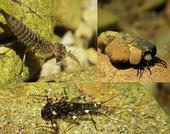- Author: Faith Kearns

Street-side stormwater facilities are turning runoff once seen as a nuisance into a resource. Also known as bioretention areas, rain gardens, and bioswales, these small stormwater facilities provide a decentralized approach to alleviating peak stormwater runoff and subsequent flood damages. These are particularly critical functions in cities like San Francisco where the storm and sanitary sewer systems are combined because they help managers to prevent dreaded “combined sewer overflow” events. As a bonus, stormwater facilities have also proved useful in promoting groundwater recharge and filtering pollutants as water percolates through soils.
While street-side facilities are effective in helping to manage...
- Author: Faith Kearns

How best to capture and store water for many different uses is a big question in California. After years of drought and now the looming possibility of a wet, El Niño-driven winter, safe-keeping any precipitation that does fall is a big priority for water managers. From reservoirs to tunnels to canals, the state's water infrastructure is vast and complicated. However, one approach with a lot of potential that has received little attention so far, at least in California, is managed aquifer recharge (also known as MAR) linked to collection of stormwater runoff.
Professor Andrew Fisher of UC Santa Cruz has been studying MAR for some time. He says it makes use of a variety of...
- Author: Vincent Lazaneo

A recent paper from Pittenger and Hodel suggested that, at 9 percent, landscape water was not a large part of the overall California water picture. While I understand the desire to defend urban landscapes and justify the amount of water currently used to maintain them, I believe that view is short-sighted and would benefit from a broader perspective. For example, we should take into account both the history of drought in California and the profound changes caused by global warming that have begun and are predicted to accelerate as the century progresses.
The historic record of our region's climate over the past 2,000 years has been scientifically...
- Author: Faith Kearns
- Author: Doug Parker

The excitement about a potentially rain-bearing El Niño is building, and hopes for a swift end to California's ongoing drought are multiplying. At the same time, many of us who have worked extensively on water issues in the state fear the momentum and progress made on much-needed water reforms will be lost.
The prospect of a rainy year raises the question: what would it take for the drought to be over? The answer to that question turns out to be more complex than it might seem.
Defining drought
It is common...
- Author: Faith Kearns, PhD

When we think water in California, we tend to think big: the Sacramento River, the American, the Delta. But, the state is also filled with small headwater streams that can be particularly easy to overlook when, during the state's dry summers, they start to resemble a series of pools rather than flowing creeks. Adding insult to injury is a longstanding view that the fish and insect communities in these intermittent streams will be less diverse than those found in the larger rivers they run into.
It is against this backdrop that scientists at the University of California, Berkeley, with support from the California Institute for Water Resources, set out to study some small creeks in the northern part of the state. They...
